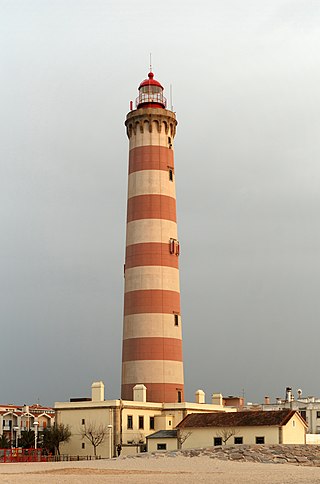Esgueira is an urban civil parish in the municipality (concelho) of Aveiro, in continental Portugal. The population in 2011 was 13,431, in an area of 17.15 km2 (6.62 sq mi).

Angústias is one of the three freguesia that comprise the urban area of the city of Horta, on the island of Faial in the Portuguese archipelago of the Azores. This is an economically active, densely populated area. The population in 2011 was 2,418, in an area of 3.79 km2. Due to its commercial nature, the parish is one of the island's primary destinations for tourism, due to the concentration of historical sights and shopping. It contains the localities Caminho do Meio, Courelas, Pasteleiro, Port Pim, Termo da Igreja and Vigia.

São José is a civil parish in the municipality of Ponta Delgada on the island of São Miguel in the Portuguese archipelago of the Azores. It is one of the constituent parts of the city of Ponta Delgada, and location of many of the island's more significant cultural and historical, commercial and residential buildings. Extending a short distance along the coast it, nevertheless includes a large mixed urban-rural constituency from the shore north to the main freeway, the Via-Rápida. The population in 2011 was 5,934, in an area of 1.66 km2.

The Abbey of St. Batholomew, more simply known as the Abbey of Arouca, was a Cistercian monastery of women dating from the 10th century. It is located in Arouca, now in the Porto metropolitan area of Portugal. For much of its existence, it was one of the most influential religious centers in that region of the country.
The Residence of Portela is a 17th-century country house located in the civil parish of Paços de Brandão, in the municipality of Santa Maria da Feira, in the Portuguese Centro district of Aveiro. It was classified as a monument in 1982.

Pousadas de Portugal is a chain of luxury, traditional or historical hotels in Portugal. Formerly run by the Portuguese State, they are now run by the Pestana Group, which in September 2003 won a public bid for the sale of 37.6% of parent company Enatur and for a 40-year running concession. It is a member of the Historic Hotels of Europe.

The Santa Apolónia Station is the oldest railway terminus in Portugal. It is situated in the civil parish of São Vicente, in the central part of the municipality of Lisbon, on the northern margin of the Tagus River in the historical district of Alfama.
Fort of São Francisco Xavier is a fortification situated along the coast of the civil parish of Nevogilde in the northern Portuguese municipality of Porto.
Miguel Simões Jacobetty Rosa was a Portuguese architect. One of his greatest works was the designing of the Estádio Nacional, located near Lisbon.

The Lighthouse of Praia da Barra, also known as the Aveiro Lighthouse, is an active lighthouse in the civil parish of Gafanha da Nazaré, municipality of Ílhavo, in the Portuguese district of Aveiro. Situated on the coastal Praia da Barra, at the southern margin of the Ria de Aveiro, it is the tallest lighthouse in Portugal, with a height of 203 feet (62 m) overseeing the barrier beach and exposed to Atlantic storms. It is open to the public and visits are held on Wednesdays from 14:00 to 17:00.

The Palace of São João Novo is a palace/residence in the civil parish of Cedofeita, Santo Ildefonso, Sé, Miragaia, São Nicolau e Vitória, in the municipality of Porto, in the Portuguese district of the same name.

Fort of Santa Cruz, is a 16th-century fortification located in the civil parish of Angústias, municipality of Horta, on the island of Faial in the Portuguese Azores. Occasionally referred to as the Castelo de Santa Cruz by locals, it is situated in the historic centre of the city, on the edge of Horta Bay. It was constructed to work in conjunction with the Fort of Bom Jesus at the mouth of the Ribeira da Conceição and Fort of Greta along the coast of the extinct spatter cone Monte da Guia, to defend the entrance to the harbour and southern access to the Bay.

The Castle of Alcácer do Sal is a medieval castle located in the civil parish of Alcácer do Sal e Santa Susana, in the municipality of Alcácer do Sal, Portuguese district of Setúbal.

The Castle of Avô is a medieval castle located in the civil parish of Avô, municipality of Oliveira do Hospital, in the Portuguese district of Coimbra.
The Church of São Salvador is a church in the civil parish of Trofa, Segadães e Lamas do Vouga, in the municipality of Águeda, in the Portuguese Centro district of Aveiro.

A Church of São João Evangelista, or Carmelite Church of Aveiro, is an 18th-century church in the Praça Marquês de Pombal, in the civil parish of Glória e Vera Cruz, in the Portuguese municipality of Aveiro. It was declared a national monument in 1910.

The Castle of Vila Nova de Cerveira is a medieval castle located in the civil parish of Vila Nova de Cerveira e Lovelhe, in the municipality of Vila Nova de Cerveira, Portuguese Viana do Castelo.

The Castle of Óbidos is a well-preserved medieval castle located in the civil parish of Santa Maria, São Pedro e Sobral da Lagoa, in the portuguese municipality of Óbidos. Historical province of portuguese Estremadura.

The Convent of Santo António da Cidade is a former-convent and public library in the civil parish of Bonfim, in the municipality of Porto, in the Portuguese district of the same name.
















